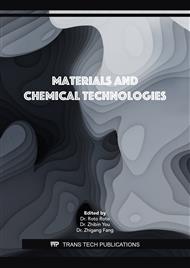[1]
Z.-X. Zhou, Y. Li, J. Zhong, Z. Luo, C.-R. Gong, Y.-Q. Zheng, S. Peng, L.-M. Yu, L. Wu, Y. Xu, High-Performance Cyanate Ester Resins with Interpenetration Networks for 3D Printing, ACS Appl. Mater. Interfaces 12 (2020) 38682-38689.
DOI: 10.1021/acsami.0c10909
Google Scholar
[2]
X. Li, T. Liu, Y. Jiao, J. Dong, F. Gan, X. Zhao, Q. Zhang, Novel high-performance poly (benzoxazole-co-imide) resins with low dielectric constants and superior thermal stabilities derived from thermal rearrangement of ortho-hydroxy polyimide oligomers, Chem. Eng. J. 359 (2019) 641-651.
DOI: 10.1016/j.cej.2018.11.175
Google Scholar
[3]
L. Xu, Y. Ma, J. Xie, W. Zhang, Z. Wu, Z. He, Sandwich-type porous polyimide film with improved dielectric, water resistance and mechanical properties, J. Mater. Sci. 54 (2019) 5952-5960.
DOI: 10.1007/s10853-018-03248-z
Google Scholar
[4]
N. Song, H. Yao, T. Ma, T. Wang, K. Shi, Y. Tian, B. Zhang, S. Zhu, Y. Zhang, S. Guan, Decreasing the dielectric constant and water uptake by introducing hydrophobic cross-linked networks into co-polyimide films, Appl. Surf. Sci. 480 (2019) 990-997.
DOI: 10.1016/j.apsusc.2019.02.141
Google Scholar
[5]
F. He, Y. Gao, K. Jin, J. Wang, J. Sun, Q. Fang, Conversion of a biorenewable plant oil (anethole) to a new fluoropolymer with both low dielectric constant and low water uptake, ACS Sustain. Chem. Eng. 4 (2016) 4451-4456.
DOI: 10.1021/acssuschemeng.6b01065
Google Scholar
[6]
X. Yin, Y. Feng, Q. Zhao, Y. Li, S. Li, H. Dong, W. Hu, W. Feng, Highly transparent, strong, and flexible fluorographene/fluorinated polyimide nanocomposite films with low dielectric constant, J. Mater. Chem. C 6 (2018) 6378-6384.
DOI: 10.1039/c8tc00998h
Google Scholar
[7]
Z. Geng, M. Huo, J. Mu, S. Zhang, Y. Lu, J. Luan, P. Huo, Y. Du, G. Wang, Ultra low dielectric constant soluble polyhedral oligomeric silsesquioxane (POSS)–poly(aryl ether ketone) nanocomposites with excellent thermal and mechanical properties, J. Mater. Chem. C 2 (2014) 1094-1103.
DOI: 10.1039/c3tc31557f
Google Scholar
[8]
H. Guo, M.A.B. Meador, J.L. Cashman, D. Tresp, B. Dosa, D.A. Scheiman, L.S. McCorkle, Flexible Polyimide Aerogels with Dodecane Links in the Backbone Structure, ACS Appl. Mater. Interfaces 12 (2020) 33288-33296.
DOI: 10.1021/acsami.0c09321
Google Scholar
[9]
R.S. Bharath, T. Chakraborthy, H. Nhalil, B. Masin, K. Ashok, H. Sreemoolanadhan, C. Oommen, S. Elizabeth, Synthesis and evaluation of PVDF–MgTiO 3 polymer–ceramic composites for low-k dielectric applications, J. Mater. Chem. C 7 (2019) 4484-4496.
DOI: 10.1039/c8tc04663h
Google Scholar
[10]
J. Mo, W. Ma, W. Zhang, J. Yuan, Structure and properties of carbon intercalated halloysite and its organosilicone hybrid film with low dielectric constant, Materials & Design 128 (2017) 56-63.
DOI: 10.1016/j.matdes.2017.04.067
Google Scholar
[11]
Q. Qi, P. Zheng, Y. Lei, X. Liu, Design of bi-modal pore structure polyarylene ether nitrile/SiO2 foams with ultralow-k dielectric and wave transparent properties by supercritical carbon dioxide, Compos. Part. B: Eng. (2019) 106915.
DOI: 10.1016/j.compositesb.2019.106915
Google Scholar
[12]
L. Wang, Z.-x. Bai, C. Liu, R. Wei, X. Liu, Porous fluorinated polyarylene ether nitrile as ultralow permittivity dielectrics used under humid environment, J. Mater. Chem. C (2020).
DOI: 10.1039/d0tc04930a
Google Scholar
[13]
L. Wang, X. Liu, C. Liu, X. Zhou, C. Liu, M. Cheng, R. Wei, X. Liu, Ultralow dielectric constant polyarylene ether nitrile foam with excellent mechanical properties, Chem. Eng. J. 384 (2020) 123231.
DOI: 10.1016/j.cej.2019.123231
Google Scholar


